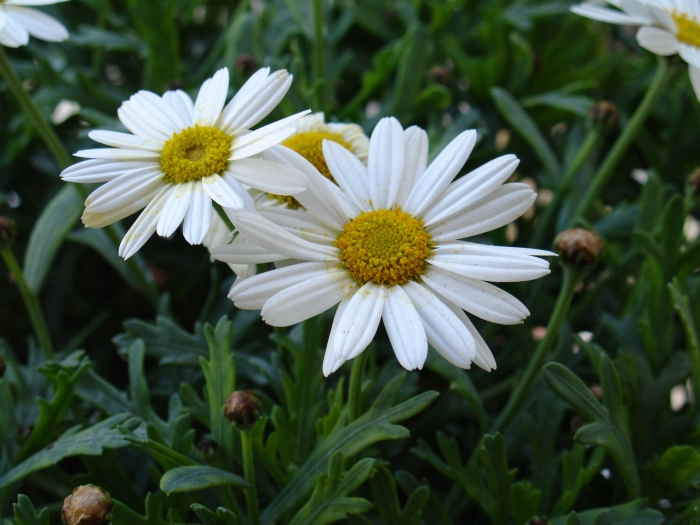Max Chrysanthemum
(Leucanthemum maximum)
Max Chrysanthemum (Leucanthemum maximum)
/
/

xcaballe
CC BY-SA 2.0
Image By:
xcaballe
Recorded By:
Copyright:
CC BY-SA 2.0
Copyright Notice:
Photo by: xcaballe | License Type: CC BY-SA 2.0 | License URL: https://creativecommons.org/licenses/by-sa/2.0 | Uploader: Stickpen | Publisher: Wikimedia Commons | Title: Leucanthemummaximum.jpg | Notes: |




















































Estimated Native Range
Summary
Leucanthemum maximum, commonly known as Max Chrysanthemum, is a perennial herb native to the Pyrenees and mountains of northern Spain, it thrives in meadows and grassy areas. The plant typically grows 30 to 70 centimeters tall and features a clump-forming habit with many large, serrated leaves at the base of the stem on winged petioles. The inflorescence is usually a single, large flower head that can exceed 8 centimeters in diameter, with a fringe of 20 to 30 white ray florets encircling a center filled with numerous densely packed yellow disc florets. Flowering occurs from early to late summer, and the blooms are highly attractive to pollinators.
It is valued for its large, showy flowers that brighten up garden borders, and it is also used in cut flower arrangements. It is easy to maintain and can be propagated by division in spring or fall. In cultivation, it prefers full sun but can tolerate part shade, and it adapts to a range of soil types, provided they have good drainage. While it requires low to medium amounts of water, consistent moisture will promote optimal growth and flowering. Potential problems include slug and snail damage, and in wet conditions, it may suffer from root rot or fungal diseases. It is not typically invasive but can spread through rhizomes and self-seeding if not managed.CC BY-SA 4.0
It is valued for its large, showy flowers that brighten up garden borders, and it is also used in cut flower arrangements. It is easy to maintain and can be propagated by division in spring or fall. In cultivation, it prefers full sun but can tolerate part shade, and it adapts to a range of soil types, provided they have good drainage. While it requires low to medium amounts of water, consistent moisture will promote optimal growth and flowering. Potential problems include slug and snail damage, and in wet conditions, it may suffer from root rot or fungal diseases. It is not typically invasive but can spread through rhizomes and self-seeding if not managed.CC BY-SA 4.0
Plant Description
- Plant Type: Herb
- Height: 1.5-2 feet
- Width: 1.5-2 feet
- Growth Rate: Moderate
- Flower Color: White
- Flowering Season: Spring, Summer
- Leaf Retention: Deciduous
Growth Requirements
- Sun: Full Sun
- Water: Medium
- Drainage: Medium, Fast
Common Uses
Bee Garden, Bird Garden, Border Plant, Butterfly Garden, Deer Resistant, Drought Tolerant, Groundcover, Rabbit Resistant, Showy Flowers
Natural Habitat
Native to meadows and grassy areas of the Pyrenees and northern Spain
Other Names
Common Names: Shasta Daisy, Daisy-Chrysanthemum, Max-Chrysanthemum, Pyrenäen-Margerite, Reuzenmargriet
Scientific Names: , Chrysanthemum maximum, Chrysanthemum grandiflorum, Leucanthemum maximum, Leucanthemum vulgare subsp. maximum, Chrysanthemum burbankii, Chrysanthemum ceratophylloides, Chrysanthemum leucanthemum subsp. maximum, Chrysanthemum leucanthemum var. maximum, Leucanthemum ceratophylloides subsp. tenuifolium
GBIF Accepted Name: Leucanthemum maximum (Ramond) DC.